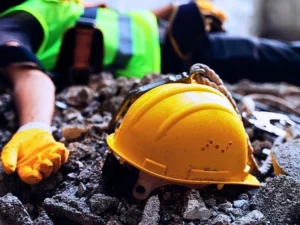The indirect costs for workplace accidents in Chicago, Illinois, are uninsured and unbudgeted expenses, including productivity loss and downtime. Other examples include increased insurance premiums, damage to the company’s reputation, and loss of employee morale. The direct costs, on the other hand, revolve around the time, labor, and material costs of a workplace accident.

Workplace Accident Statistics in Illinois
Private employers in Illinois reported 102,000 nonfatal illnesses and injuries, with an incidence rate of 2.6 cases per 100 workers in 2021. These figures imply that Illinois has the same incidence rate of nonfatal injuries and illnesses as the national rate (which is 2.7). On the other hand, local and state government agencies reported 22,700 illness and injury cases with an incidence rate of 4.5 per 100 workers.
Getting Legal Support and Representation
Retain a workers’ compensation lawyer shortly after getting injured or discovering you have developed a job-related illness. Your lawyer will review the details of your case during the initial consultation to determine your eligibility.
Your lawyer will determine which benefits you may recover and their amounts. The lawyer will then file a claim and communicate and negotiate with the workers’ comp insurer on your behalf.
The lawyer will strive to get you the highest compensation possible during all engagements with the insurer. Your lawyer will also discuss your options for covering medical bills when workers’ comp is denied.
Direct vs. Indirect Costs of a Workplace Injury
The main difference between direct and indirect cost of a workplace injury is that workers’ compensation insurance covers the former, but does not cover the latter. These two costs arises when a workplace accident occurs. As such, businesses must factor them when dealing with the consequences of injuries or losses sustained in an accident at their premises.
Examples of Direct Costs
Companies should consider the direct costs of workplace accidents when calculating the cost of a workplace accident. They include costs for legal services, workers’ compensation payments, and medical expenses. Here are examples of the direct costs of workplace accidents:
- Legal actions and fines – costs associated with administrative time, legal services, and fines
- Medical bills – costs of paying for medical care and treatment of injured employees, depending on the type of injury
- Lost time wages for the injured employee – covered by worker’s compensation for work time that an employee loses due to an injury
- Disability settlement – covered by workers’ compensation for any eligible disability that the injured worker sustains
- Vocational rehabilitation costs – constitute expenses that an employee incurs during rehabilitation after suffering an injury
- Dependent or death benefits – costs incurred in compensating surviving dependents or spouse of a recently deceased employee whose death resulted from a workplace injury
Direct costs also include, case management expenses – covered by workers’ compensation for the company’s expenses associated with handling the case, and claim investigation expenses – incurred in investigating a workers’ compensation claim.
Indirect Costs for Workplace Accidents in Illinois
The indirect costs for workplace accidents constitute hidden, or additional costs not covered by insurance. These costs are difficult to measure since they are less visible. Despite this, they can affect the company’s reputation and employee morale.
Indirect costs may range from lost productivity and increased insurance premiums to loss of employee morale and turnover, depending on the workplace accident and resulting injury. Here’s a breakdown of these indirect costs:
Lost Productivity and Downtime
Productivity is the efficiency of an organization or its workers to convert inputs (labor and capital) into outputs (products or services). It increases when output increases at a faster rate than the input. A company can record high productivity by creating safer and healthier workplaces free of hazards known to cause accidents.
Productivity rates must be consistent for a company to be successful. Productivity growth allows the company to produce more services and goods from the same work input. It fosters confidence and morale in employees, making them more efficient at work.
Low productivity is a sign of poor decision-making, workflow issues, or staffing problems. Workplace accidents and injuries are also a leading cause of low productivity. The reason is employees injured at work may need to take time off or may develop lifelong disabilities that affect their physical ability to work.
Downtime is another indirect cost of accidents. Since unplanned downtime is unanticipated and unintentional, preventing it can be problematic. It may occur due to human errors, workplace accidents, natural disasters, or malicious attacks. Duties of an employee who sustains a condition that qualifies as a work-related injury will have to be performed by someone else. Without an established continuity plan to deal with this issue, there might be downtime in the department where that employee worked.
Increased Insurance Premiums
Insurance companies consider the cost of workers’ compensation benefits, litigation expenses, and civil liability damages when determining insurance premiums for businesses. They also look at the employees on payroll, their experience, and work performed. However, businesses can improve workplace safety to earn favorable premiums if their claim costs are lower than their competitors’ claims.
The insurer pays fewer claims when fewer workers get sick or injured. On the other hand, the insurer will have to pay out many claims if the number of workplace injuries or illnesses is high. Eventually, the insurer will increase the premiums to cater to the risk of covering a business with higher cases of workplace accidents.
Damage to Company Reputation
Safety and health issues at the workplace can damage a company’s reputation, which is costly to repair. The workplace hazard will get recorded and may reach the public, damaging the company’s reputation further. A tarnished reputation can result in a loss of trust from customers and decreased sales revenue.
Opinions and beliefs about an organization must be positive for the organization to attain the highest level of success. This is because the market will have its preconceived notions about the company. Purchasing decisions are based on people’s experiences and reviews about services or products.
As such, businesses should create plans to combat workplace accidents and injuries. They should also take full responsibility for any accidents on their premises and find solutions to prevent them from reoccurring.
It is also crucial for businesses to be ready to respond to their employees’ complaints about occupational safety. They should also find ways to counter news reports or media coverage about threats to their reputations.
Employee Morale and Turnover
It is easier to prevent accidents at the workplace when employees are confident that their managers value morale, safety, and health. Employees can be more dedicated and productive if their work-life balance is healthy.
Companies can gain a competitive advantage by preventing workplace accidents and injuries. Doing this can also help improve employee retention rates, leading to more applications from highly qualified candidates. They can have more staff on standby in the event of a downtime from a workplace injury or illness.
High employee turnover rates mean a company will incur an otherwise avoidable cost of recruiting and training new employees. Low employee morale can negatively affect overall performance, customer satisfaction, and workplace culture.
Safety training can help improve these critical metrics. The training reduces workplace fatalities by fostering a culture of accountability, communication, and trust. They also help create a sense of engagement and make employees feel that the organization values their well-being and safety.
Other Examples of Indirect Costs
After a workplace accident has occurred, a company may have to deal with OSHA enforcement actions and fines. These enforcement actions are unexpected and costly.
If a business loses some of its workforce due to a workplace accident, it may have to hire additional human resources. The additional staff may include medical advisors, third-party consultants, and legal counsel. The company will also spend money on administrative time spent by staff members like supervisors, safety personnel, and HR managers to coordinate efforts to return to work and complete documentation.
Property or equipment damage resulting from workplace accidents also qualifies as indirect costs. These damages may need costly replacements or repairs, increasing the operational costs of a business. The business may also suffer substantial revenue losses if the accident leads to permanent or temporary closure of a department or facility.
Prevention and Mitigation Strategies
Businesses and employees should adopt accident prevention plans to keep their workplaces healthy and safe. These plans can help them avoid lost productivity, legal issues, injured employees, and damaged buildings. Employees can do their work with few distractions and help grow the business when they feel valued and protected.
Workplace hazards usually vary with the industry. Either way, certain practices can help reduce these hazards and avoid both direct and indirect costs of workplace accidents. Discussed below are these practices in detail:
Implement Effective Safety Measures
Providing safe work environments for employees is part of the duties of a company’s management team. Industries like mining and construction have hazards that make it crucial for employees to understand and adhere to safety protocols. They also require administrators to enforce safety plans to prevent workplace hazards and injuries.
Safety measures should encompass a comprehensive safety and wellness plan. The plan should highlight all appropriate procedures and safety policies for documenting any safety incidents. It should also explain procedures for alerting management after identifying potential hazards and completing safety-related tasks.
With a safety plan, employees will know what to do in emergencies. As a result, there will not be legal issues or miscommunication if a workplace accident occurs. Business operations can also resume with little interference and zero downtime.
Businesses need to complete safety evaluations while implementing safety measures. Doing this can help them identify possible hazards and trends. A typical safety evaluation involves walking around the business premises, looking for potential risks, and reviewing previous accident reports.
Hiring a safety officer can also help a company focus on accident prevention consistently. The safety officer’s role is to determine risks, develop a safety plan, implement safety procedures, and enforce policies. The officer can also ensure the company adheres to federal and state industry-specific regulations.
Training Programs and Safety Protocols
Lack of awareness of safety hazards is among the reasons workplace accidents occur. Educating staff members on proper workplace procedures and potential safety hazards can help them understand the risks related to their occupations. It can also help inform them about measures they can take to prevent an accident and injury.
Businesses can hold regular training to enforce existing policies or inform workers about changes to their safety protocols. Depending on the industry, the training may cover accident reporting, procedures for handling hazardous substances, and proper lifting techniques. The training can also inform employees about the locations of emergency devices like fire extinguishers.
Many companies demand that employees in certain positions undergo mental and physical screenings before accepting a job. The screenings ensure that recruits are mentally and physically capable of handling job duties. They may include medical history reviews, physical exams, cardiac stress tests, and vision/hearing tests.
Employees in risky work settings may need personal protective gear to keep them safe. The gear includes goggles, helmets, gloves, and high-visibility clothing like reflective vests. Ear coverings, foot protection, harnesses, and waist belts can also be part of the personal protective equipment (PPE).
Besides investing in PPEs, employers should train their employees on proper use of this gear. They should also perform impromptu safety audits to establish if employees use their gear appropriately. Employers particularly in warehousing and construction industry should invest in other safety equipment, including first aid kits, signs, and traffic cones.







